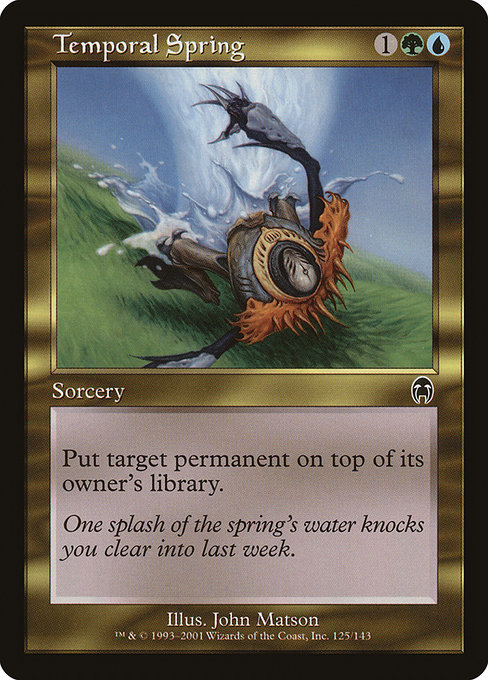
Image courtesy of Scryfall.com
Temporal Spring and the Art of Designing Within Constraints
In the world of Magic: The Gathering, constraints aren’t shackles; they’re the playgrounds where designers sketch out clever, memorable ideas. The card at the heart of this discussion—Temporal Spring—launched in Apocalypse on June 4, 2001, as a common green/blue sorcery with a modest mana cost of {1}{G}{U}. Its text is compact: “Put target permanent on top of its owner's library.” That single line quietly demonstrates a philosophy of design that values versatility, feel, and clever interaction over flash and brute force. The fact that it’s a common rarity makes its integrity even more impressive: easy to grasp, hard to overreach. 🧙♂️🔥
Constraints as a design compass
- Color identity and power curve: Green and blue, together, emphasize planning, manipulation, and tempo. Temporal Spring uses that duo to offer a broad utility while remaining safely within the power envelope of a common card. The schedule—three mana for a one-shot effect that affects any permanent—pushes players to think in terms of timing, not brute force. 💎
- Rarity and accessibility: As a common, the design must be approachable and reliable in draft, sealed, and casual formats. The solution is elegant precisely because it avoids dramatic power—its strength lies in flexibility and timing, not a flashy arrow of pure value. This restraint invites experimentation without risking the game’s balance. 🎨
- Sorcery speed and scope: Being a sorcery controls the timing; you can’t surprise the opponent with a second instant-speed move. That limitation nudges designers toward creating a multi-use effect rather than a single-tier blowout, encouraging strategic planning and deck-thought instead of raw tempo. 🧭
Crafting space from a single move
The genius of Temporal Spring lies in how far a simple instruction can reach. By placing a permanent on the top of its owner’s library, you don’t erase the threat or remove it from play—you shape what the next draw will be. In control mirrors, this can derail an opponent’s plan by forcing them to draw into a less optimal answer, while preserving your own draw order for a critical response. In broader terms, it’s a masterclass in sequencing: the card asks you to forecast one turn ahead and to orchestrate the board with less about what you do now and more about what you force your opponent to see in their next draw step. 🧙♀️🎲
The set’s Apocalypse framing—time-twisting, reality-bending undercurrents—finds a neat echo in this spell. The flavor text, “One splash of the spring's water knocks you clear into last week,” captures the whimsy and misdirection designers sought: memory as a resource, and time as a tactical instrument. The artwork by John Matson anchors that idea with a crisp 1997 frame aesthetic, a reminder that even long-vanished design eras can feel fresh when the concept is right. 🌀⚔️
Design is a game of fit. If a mechanic can serve multiple roles—tempo, card selection, or setup—it earns a place at the table. Constraints force you to be surgical with each word, and the result can feel inevitable in hindsight.
From concept to table: why this card remains instructive
Temporal Spring is a compact case study in how design can maximize impact with restraint. The synergy between green’s affinity for planning and blue’s penchant for control enables a thinking player to leverage top-deck dynamics without requiring extra setup. While the card’s straightforward text could seem modest, the strategic space it opens up is surprisingly broad: you can disrupt, you can set up, you can even create tempo plays by encouraging your opponent to play into a draw that you’ll next capitalize on. And because it is a common, it yields value in Limited formats and casual leagues alike, a nod to the era when designers were balancing complexity with accessibility in an ongoing narrative. 🧙♂️💎
Collectors also find charm in Temporal Spring. Foil versions have notable appeal in a hobby that treasures the shine of nostalgia, while the nonfoil print remains a practical, affordable staple for players who relish drafting blue-green control shells or top-deck setups in casual tournaments. The card’s EDH/Commander presence is a matter of personal style rather than meta definition; it’s the kind of piece that gathers a quiet following among players who enjoy the elegance of a well-placed top card and the story that comes with a 2001 print from Apocalypse. 🎲🎨
For modern designers and players, Temporal Spring offers a blueprint: if you’re working within tight color boundaries and a modest mana cost, give yourself room to maneuver through versatility and timing. Let the mechanic’s reach extend through the deck and the flow of the game, not just the stat line. And when you pair that design mindset with evocative flavor and solid art, you create a card that still feels relevant, even as the multisets around it evolve. 🧭🧙♂️
Curious to explore more vintage design stories or to browse where this card sits in the broader MTG ecosystem? The timeless nature of a well-crafted constraint makes Temporal Spring a perfect talking point for conversations about how limits drive artistry in games we love.